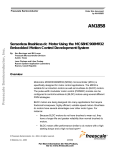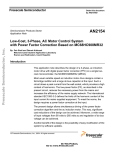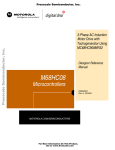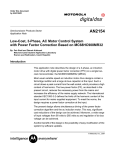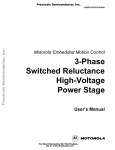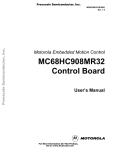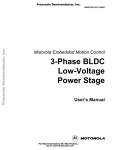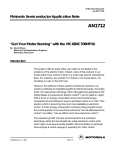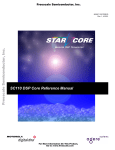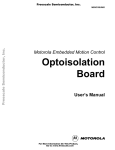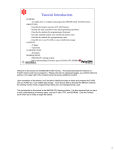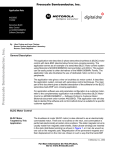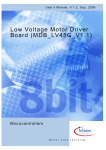Download AN1857: A 3-Phase ac Induction Motor Control System Based on
Transcript
Freescale Semiconductor, Inc. 16 Order this document by AN1857/D Motorola Semiconductor Application Note Freescale Semiconductor, Inc... AN1857 A 3-Phase ac Induction Motor Control System Based on the MC68HC908MR32 By: Bill Lucas and Ken Berringer Motorola Microcontroller Division Austin, Texas Software Written By: Radim Visinka, Petr Lidak, Pavel Kania, and Petr Stekl Roznov System Application Laboratory Roznov, Czech Republic Introduction The use of microcontroller technology has enabled the design of energyefficient and cost-effective motor control systems. Using microcontrollers (MCU) with specialized pulse-width modulator interfaces and integrated protection architecture allows a reasonable approach to reduce total system cost and increase overall performance. This application note describes such a system based on the Motorola MC68HC908MR32 (MR32) motor control specific MCU, optoisolation, and power electronics. A discussion of the MR32 MCU, hardware design of the control board, optoisolation interface, power electronics, and the required software to control a 3-phase induction motor is presented. © Motorola, Inc., 2000 AN1857 For More Information On This Product, Go to: www.freescale.com Freescale Semiconductor, Inc. Application Note A Look at the MC68HC908MR32 Motor Control Microcontroller The MR32 is a new member of the low-cost, high-performance M68HC08 (HC08) Family of 8-bit MCUs that are designed specifically for midrange motor control applications. Freescale Semiconductor, Inc... The Motorola HC08 Family of MCUs is an enhanced, upward object code compatible architecture that evolved from the M68HC05 (HC05) Family. All MCUs in the family use the enhanced HC08 central processor unit (CPU08) that includes new addressing modes, many new instructions, and the performance improvements to existing instructions that result from the introduction of instruction pipelining. MCUs in the HC08 Family are available with a variety of package types, input/output (I/O) modules, and various memory sizes and types. Features of the MR32 motor control MCU include: • High-performance M68HC08 (CPU08) architecture • Fully upward-compatible object code with M68HC05, M146805, and M68HC(7)05 Families • 8-MHz internal bus frequency • 32 Kbytes of on-chip FLASH memory • FLASH data security • 768 bytes of on-chip random-access memory (RAM) • 12-bit, 6-channel center-aligned or edge-aligned pulse-width modulator (PWMMC) module • Serial peripheral interface module (SPI) • Serial communications interface module (SCI) • 16-bit, 4-channel timer interface module (TIMA) • 16-bit, 2-channel timer interface module (TIMB) • Clock generator module (CGM) • Digitally filtered low-voltage inhibit (LVI) • 10-bit, 10-channel analog-to-digital converter (ADC) AN1857 2 MOTOROLA For More Information On This Product, Go to: www.freescale.com Freescale Semiconductor, Inc. Application Note A Look at the MC68HC908MR32 Motor Control Microcontroller Freescale Semiconductor, Inc... System protection features include: • Optional computer operating properly (COP) reset • Low-voltage detection with optional reset • Illegal opcode detection with optional reset • Illegal address detection with optional reset • Fault detection with optional PWM disabling • Low-power design, fully static with wait mode • Master reset pin (RST) and power-on reset (POR) • 64-pin plastic quad flat pack (QFP) Some CPU08 features include: • Enhanced M68HC05 programming model • Extensive loop control functions • 16 addressing modes (eight more than the HC05) • 16-bit index register and stack pointer • Memory-to-memory data transfers • Fast 8 by 8 bit multiply instruction • Fast 16/8 bit divide instruction • Binary-coded decimal (BCD) instructions • Optimization for controller applications • Improved C language support This application note does not discuss in great detail each of the I/O modules resident on the MR32. Figure 1 shows a block diagram of the MR32. For a detailed description of the MR32, refer to 68HC908MR32, 68HC908MR16 Technical Data: Advance Information, Motorola document order number MC68HC908MR32/D. The MR32’s PWMMC module and its protection features make the device an excellent choice for use in an embedded motor control system. A review of the PWMMC module and its features is included here. AN1857 MOTOROLA 3 For More Information On This Product, Go to: www.freescale.com Freescale Semiconductor, Inc. Application Note TIMA 4-CH 10-CH 10-BIT SPI SCI LVI TIMB 2-CH Freescale Semiconductor, Inc... ADC CPU08 32K FLASH SIM 768 BYTES RAM CGM 13 I/0 PIN PWM1 PWM2 PWM3 PWM4 PWM5 PWM6 PWMMC POLARITY SIGNALS FAULT INPUTS Figure 1. MC68HC908MR32 Block Diagram MC68HC908MR32 Pulse-Width Modulator The pulse-width modulator module (PWMMC) resident on the MR32 is specifically designed to provide pulse-width modulated outputs to drive a power stage connected to a dc servo, brushless dc, or 3-phase ac motor system. The PWMMC module can be partitioned and configured in several ways, depending on the specific motor control application. Figure 2 shows a block diagram of the PWMMC module and is referenced throughout this explanation of the PWMMC generator. Features of the MR32 PWM include: • Three complementary PWM pairs or six independent PWM signals • Complementary mode features include: – Dead-time insertion – Separate top/bottom pulse-width correction via current sensing or programmable software bits • Edge-aligned PWM or center-aligned PWM signals • PWM signal polarity • 20-mA current sink capability on all PWM outputs • Manual PWM output control through software • Programmable fault protection AN1857 4 MOTOROLA For More Information On This Product, Go to: www.freescale.com Freescale Semiconductor, Inc. Application Note MC68HC908MR32 Pulse-Width Modulator OR UP/DOWN COUNTER PRESCALER ÷ 1, 2, 4, OR 8 ÷ 1, 2, 4,O R 8 PWM GENERATORS COMPARATORS DOUBLE BUFFERED REGISTERS Freescale Semiconductor, Inc... PRESCALER CONTROL FAULT PROTECTION PWM MODE SELECT OUTPUT PWM1 PWM2 DEADTIME INSERTION FAULT PARTITIONING POLARITY CONTROL PWM3 PWM4 DIRECT OUTPUT CONTROL DISTORTION CORRECTION MOTOR CURRENT POLARITIES PWM RELOAD AND INTERRUPT INTERRUPTS FAULT MODE SELECT HIGH CURRENT DRIVERS PWM5 PWM6 SYSTEM FAULTS Figure 2. PWMMC Module Block Diagram One of the most important features of the PWMMC is its ability to “shut itself down” when a system fault is detected. When dealing with a system that potentially could have hundreds of amps of peak current, reacting to faults such as overcurrent or overvoltage conditions is an absolute necessity. Fault protection is discussed here first. We then work our way from the outputs of the PWM inward. A discussion of the inputs to the PWM follows. The six outputs of the PWMMC generator can be configured as individual pulse-width modulated signals where each output can be controlled as an independent output. Another option is to configure the outputs in pairs, with the outputs complementary or not, so driving complementary top and bottom transistors on a power stage becomes an easy task. The outputs of the PWMMC are capable of sinking up to 20 mA. That drive capability allows for direct drive of optocouplers without the need of additional drivers. To prevent erroneous signals from being output from the PWMMC module while loading new values, the bulk of the registers are double buffered and new output is inhibited until a bit in a PWM control register, load okay (LDOK), is set, indicating it is okay to output the new values. AN1857 MOTOROLA 5 For More Information On This Product, Go to: www.freescale.com Freescale Semiconductor, Inc. Application Note Freescale Semiconductor, Inc... Fault Protection Conditions can arise in the external drive circuitry, requiring that the PWM signals become inactive immediately. These conditions include overcurrent, overvoltage, overtemperature, or other error conditions. The four fault input pins on the MR32’s PWMMC module can be configured to react in a number of different ways, upon the detection of a fault. Each fault input has its own interrupt vector. In all fault conditions, the output of the PWM generator is forced to a known inactive state. A number of fault control and recovery options is available to the systems architect. In some cases, it may be desirable to selectively disable PWM(s) solely with software. Manual and automatic recovery mechanisms are available that allow certain acceptable fault situations to occur, such as starting a motor and using a fault input to limit the maximum startup current. The fault inputs can be partitioned if the MR32 is used to control multiple motors. PWM Output Alignment Depending on the system design, there is a choice between edge- or center-aligned PWM signals output from the MR32’s PWM generator. The PWM counter uses the value in the timer modulus register to determine its maximum count. In center-aligned mode, a 12-bit up/down counter is used to create the PWM period. The PWM resolution in center-aligned mode is two clock periods (highest resolution is 250 ns @ a processor speed of 8 MHz). The PWM period will be equal to: [(timer modulus) x (PWM clock period) x 2]. In edge-aligned mode, a 12-bit up-only counter is used to create the PWM period. Therefore, the PWM resolution in edge-aligned mode is one clock (highest resolution is125 ns @ a processor speed of 8 MHz). Again, the timer modulus register is used to determine the maximum count. The PWM period will be equal to: [(timer modulus) x (PWM clock period)]. AN1857 6 MOTOROLA For More Information On This Product, Go to: www.freescale.com Freescale Semiconductor, Inc. Freescale Semiconductor, Inc... Application Note MC68HC908MR32 Pulse-Width Modulator PWM Counter Timebase To permit lower PWM frequencies, a prescaler is provided which will divide the PWM clock frequency by 1, 2, 4, or 8. This prescaler is buffered and will not be used by the PWM generator until the LDOK bit located in a PWM control register is set and a new PWM reload cycle begins. PWM Load Operations When generating sine waves to a motor, an interrupt routine is typically used to step through a sine table located in FLASH memory, scale that sine value, and output the result to the system from the PWM generator. The rate at which the sine table is scanned can be derived from an interrupt from the PWM generator. The PWM module can be programmed to provide an interrupt rate of every one, two, four, or eight PWM reload cycles. Direct Output Control In some cases, the user may desire to bypass the PWM generator and directly control the PWM outputs. A mechanism exists to disconnect the PWM generator from its outputs and directly control the six PWM outputs. When this mode is used, the PWM generator continues to run; however, its normal PWM output is disabled, overridden by direct output. Dead-Time Insertion When the PWM generator is used in complementary mode, automatic dead-time insertion can be provided to prevent turning on both top and bottom inverter transistors in the same phase leg at the same time. When controlling dc-to-ac inverters, the top and bottom PWMs in one pair must never be active at any given time. CAUTION: If the top and bottom transistors are turned on simultaneously, large currents will flow through the two transistors as they attempt to discharge the bus supply voltage. The transistors could be weakened or destroyed. Simply forcing the two PWMs to be inversions of each other is not always sufficient. Since a time delay is associated with turning off the transistors in the motor drive, there must be a “dead-time” between the deactivation of one PWM power transistor and the activation of the opposite transistor in a top and bottom pair. Dead-time can be specified in the dead-time write-once register. This 8bit value specifies the number of CPU clock cycles to use for the deadtime. AN1857 MOTOROLA 7 For More Information On This Product, Go to: www.freescale.com Freescale Semiconductor, Inc. Application Note Freescale Semiconductor, Inc... Motor Phase Current Polarity Sensing Inserting dead-time to protect the top/bottom inverter transistors in a motor drive system is almost always a necessity for ac induction motors. However, inserting this dead-time does not come without a price. For instance, when dead-time is inserted, the motor voltage is allowed to float momentarily during the dead-time interval, creating distortion in the motor’s current waveform. This distortion can be aggravated by dissimilar turn-on and turn-off delays in the top and bottom transistors. Three current sensing input pins on the MR32 are labeled IS1–IS3. These inputs are sampled during the dead-time period. The user needs to provide current direction sensing hardware and feed the sensing hardware outputs into the IS1–IS3 inputs. The software then will compute compensated PWM values and place the two values in an odd/even PWM register pair. From the current direction sensing information, the PWM module automatically selects either the odd or even numbered PWM value register to be used by the PWM generator, thus greatly improving upon the sine wave output quality from the power stage. System Hardware The system consists of several printed circuit boards, power supplies and a 3-phase induction motor. This section contains a brief description of the individual printed circuit boards (PCB) that comprise the system. WARNING: The motor control system described in this application note is capable of operating at dangerous voltages and is capable of supplying high amounts of power to rotating machines. Power transistors, PFC coil, and the motor can reach temperatures hot enough to cause burns. To facilitate safe operation, the highvoltage input power to the power board should come from a current-limited dc laboratory power supply. Before moving test or oscilloscope probes, making connections, etc., it is generally advisable to power down the high-voltage power supply. When high voltage is applied, using only one hand for operating the test setup minimizes the possibility of electrical shock. Operation in laboratory setups that may have grounded tables and/or chairs should be avoided. Wearing safety glasses, avoiding ties and jewelry, and using shields also are advisable. AN1857 8 MOTOROLA For More Information On This Product, Go to: www.freescale.com Freescale Semiconductor, Inc. Application Note System Hardware MR32 Control Board For a more detailed description of the MR32 control board, refer to Motorola’s Embedded Motion Control Series MR32 Control Board User’s Manual (Motorola document order number MEMCMR32CBUM/D) that comes with board (kit #ECCTR908MR32). Freescale Semiconductor, Inc... This document can also be downloaded from the web at http://mcu.motsps.com/documentation/hc08/devhc08.html. The control board is designed as an aid for hardware and software design of single, 3-phase, permanent magnet, brush and brushless dc motor drive applications. The control board does not contain the MR32 microcontroller. The control board is designed to be directly connected to an MR32 EM (emulator) board, which is part of an MMDS/MMEVS emulation system connected by an impedance matched ribbon cable. A daughter board is designed to house the MR32 and will plug into the control board in place of the emulator cable. With the daughter board plugged into the control board, standalone operation of the system is possible. Because this application note is intended for use with a 3-phase ac induction motor, only the circuitry resident on the MR32 control board pertaining to the 3-phase ac motor is discussed here. Applications of the control board with other types of motors are covered in additional application notes. Figure 3 shows a complete block diagram of the control board. Control board features include: • Six motor control PWM outputs with LED indicators • Speed control potentiometer • Optoisolated half duplex RS-232 interface • Start/Stop and forward/reverse switches • Hall effect inputs (for brushless dc motor control) • Back-EMF inputs (for brushless dc motor control) • Tachometer input configuration jumpers • 2-position DIP switch for user option control • Emulator/Daughter board connectors • Processor reset switch • Two system fault inputs • Nine analog inputs AN1857 MOTOROLA 9 For More Information On This Product, Go to: www.freescale.com Freescale Semiconductor, Inc. Application Note Three software-controlled LEDs On-board regulated power supply Motor I/O interface via a ribbon cable connector TERMINAL I/F OPTO-ISOLATED FORWARD/REVERSE RS-232 SWITCH START/STOP SWITCH Freescale Semiconductor, Inc... EMULATOR/ PROCESSOR CONNECTOR dc POWER 12–15 Vdc REGULATED POWER SUPPLY STATUS LEDS CONFIG JUMPERS • • • SPEED POT RESET SWITCH OPTION SWITCHES PWM LEDS OPTO/POWER DRIVER I/O CONNECTOR TACH INPUT HALL EFFECT INPUTS 40-PIN CONNECTOR BACK-EMF CURRENT/TEMP INPUTS SENSE INPUTS PWM MISC. PWR AND OUTPUTS (6) CONTROL I/O OVERCURRENT/ OVERVOLTAGE INPUTS Figure 3. MC68HC908MR32 Control Board Block Diagram For a better understanding of the control board, a description of some of its circuits follows. Fault Inputs Two system fault inputs to the control board are designed to protect the power stage: system bus overvoltage and system bus overcurrent. The input signals for these fault comparators originate from signals on the power board. If an optoisolation board is used in the system, these signals are optocoupled and transparently passed to the control board as an analog signal. The comparator circuits provide digital signals to the MR32’s fault 1 and fault 2 inputs, respectively. These faults, should one or both occur, will force the PWM generator into a known inactive state, protecting the power stage outputs. Figure 4 is a schematic of the circuit used for both of the fault inputs. The potentiometer, connected to the inverting (–) input of the comparator, sets its threshold. When the input from the power board or optoisolation board exceeds the comparator threshold (voltage at the inverting input to the comparator), the respective fault input to the MR32 is driven to a logic 1, triggering a fault input to the PWM generator. AN1857 10 MOTOROLA For More Information On This Product, Go to: www.freescale.com Freescale Semiconductor, Inc. Application Note System Hardware Adjusting the set-point of the potentiometer allows the user to vary the acceptable system bus current and bus voltage thresholds for fault generation. Approximately 20 mV of hysteresis is included in the circuit to aid with noise immunity. I_sense/ V_sense Input 15 kΩ 15 kΩ 1MΩ +5V_D 68 pF +5V_A_ref Freescale Semiconductor, Inc... 10 kΩ 7 10 kΩ GNDA 6 + OVERVOLTAGE - LM339D I_DCB_ref/V_DCB_ref Figure 4. Fault Generation Circuit Speed Sensing One method used to establish the speed of a motor is to use the analog ac output signal from a tachometer generator that is connected to the shaft of the motor. A 16-pole tachometer is coupled to the shaft of the motor as shown in Figure 19. The conditioned signal can then be carried into a timer interrupt on the MR32. The period between interrupts is used to calculate motor shaft speed. The circuit in Figure 5 is used to “square” the ac signal from the tachometer output into a digital signal acceptable to the timer interrupt input. The input of this circuit has a threshold of approximately 180 mV. Its input hysteresis is set at approximately 20 mV to aid with noise immunity. 330 kΩ +5V_A_ref +5V_D +15V_A_ref 15 kΩ 3.3 kΩ 1 2 3.3 kΩ 10 kΩ 3 2.2 kΩ 5 4 TACHOMETER INPUT GNDA GNDA MMSZ5230BT1 220 nF/100 V 560 Ω GNDA GNDA + – 2 LM339D TO TIMER INTERRUPT 12 GND Figure 5. Tachometer Input Circuit AN1857 MOTOROLA 11 For More Information On This Product, Go to: www.freescale.com Freescale Semiconductor, Inc. Application Note Optoisolated RS-232 Interface In the event the control board is used in a system that does not use an optoisolation board between the control board and the power stage, connection to a computer terminal or PC could be dangerous. The circuit in Figure 6 is the schematic of a half-duplex optoisolated RS-232 interface used on the MR32 control board. This isolated terminal interface provides a margin of safety between the motor control system and a computer terminal or PC. Freescale Semiconductor, Inc... The EIA RS-232 specification states the signal levels can range from 3volts to 25volts. A mark is defined by the EIA RS-232 specification as a signal that ranges from –3 volts to –25 volts. A space is defined as a signal that ranges from +3 volts to +25 volts. Therefore, to meet the RS-232 specification, signals to and from a terminal must transition through 0 volts as it changes from a mark to a space. Breaking the isolated RS-232 circuit into input and output sections makes a simpler explanation of the circuit. To send data from a PC to the MR32 control board, it is necessary to satisfy the SCI input on the MR32. In the idle condition, the SCI input must be at a logic 1. To accomplish that, the transistor in U6 must be off. The idle state of the transmit data line (TXD) on the PC serial port is a mark (–3 V to –25 V). Therefore, the diode in U6 is off and the transistor in U6 is off, yielding a logic 1 to the SCI input. When the start bit is sent to the SCI from the PC’s serial port, the PC’s TXD transitions from a mark to a space (+3 V to +25 V), forward biasing the diode in U6. Forward biasing the diode in D3 turns on the transistor in U6, providing a logic 0 to the input of the SCI. Simply stated, the input half of the circuit provides input isolation, signal inversion, and level shifting from the PC to the MR32’s SCI port. An RS-232 line receiver, such as an MC1489, serves the same purpose without the optoisolation function. To send data from the MR32 control board to a PC serial port input, it is necessary to satisfy the PC’s receive data (RXD) input requirements. In an idle condition, the RXD input to the PC must be at mark (–3 V to –25 V). The data terminal ready output (DTR) on the PC outputs a mark when the port is initialized. The request to send RTS output is set to a space (+3 V to +25 V) when the PC’s serial port is initialized. Because the interface is half-duplex, the PC’s TXD output is also at a mark, as it is idle. The idle state of the transmit data line (TXD) on the MR32’s SCI AN1857 12 MOTOROLA For More Information On This Product, Go to: www.freescale.com Freescale Semiconductor, Inc. Application Note System Hardware Freescale Semiconductor, Inc... is a logic 1. The logic 1 out of the SCI’s output port forces the diode in U7 to be turned off. With the diode in U7 turned off, the transistor in U5 is also turned off. The junction of D12 and D15 are at a mark (–3 V to –25 V). With the transistor in U5 turned off, the input is pulled to a mark through current limiting resistor R53, satisfying the PC’s serial input in an idle condition. When a start bit is sent from the MR32’s SCI port to the output of the MR32’s SCI, output transitions to a logic 0. That logic 0 turns on the diode in U5, thus turning on the transistor in U7. The conducting transistor in U5 passes the voltage output from the PC’s RTS output, that is now at a space (+3 V to +25 V) to the PC’s receive data (RXD) input. Capacitor C30 is a bypass capacitor used to “stiffen” the mark signal. The output half of the circuit provides output isolation, signal inversion, and level shifting from the MR32’s SCI output port to the PC’s serial port. An RS-232 line driver, such as an MC1488, serves the same purpose without the optoisolation function. ISOLATION BARRIER +5V_D 1 kΩ 1 kΩ SFH6106 5 9 8 3 7 2 TXD RTS RXD RxD + 4 GND GND DTR 2.2 µF 4.7 kΩ 330 Ω 6 1 (+12 Vdc) SFH6106 +5V_D TxD Figure 6. Optoisolated RS-232 Circuit AN1857 MOTOROLA 13 For More Information On This Product, Go to: www.freescale.com Freescale Semiconductor, Inc. Application Note Back-EMF Zero-Crossing Detection Back-EMF zero-crossing detection enables position recognition when controlling brushless dc motors. Sensorless brushless dc motor control is not discussed in this application note. Rather, refer to Sensorless Brushless dc Motor Using the MC68HC908MR32 Embedded Motion Control Development System, Motorola document order number AN1858/D, for more information. Freescale Semiconductor, Inc... To perform distortion correction when controlling a 3-phase ac induction motor, it is necessary to provide phase current polarity information to the MR32. That information is detected, signal conditioned on the power board, and passed transparently through the optoisolator board to the control board. The three zero-crossing signals from phases A, B and C are routed into the three input current sense IS1–IS3 inputs of the MR32. They are also routed to the back-EMF selection logic, shown in Figure 7. The back-EMF selection logic is designed to provide an interrupt to the MR32 channel 2 of timer A upon each phase zerocrossing, provided the other input to the NAND gate is at a logic 1. The three open collector NAND gates shown in Figure 7 (U7A, U7B, and U7C) are wire ORed such that any one of the these outputs transitioning to a logic 0 will provide an interrupt to the MR32’s timer A. The system software uses the MUXA, MUXB, and MUXC inputs to the NAND gates to enable a particular phase to have an ability to interrupt the processor. During system operation, the software is aware of the window when a particular zero-crossing interrupt should occur for any given phase. MUXA, MUXB, and MUXC inputs to the NAND gates are enabled for each particular phase during its computed zero cross window. Using this technique, the system is more noise robust, eliminating noise glitches from triggering false interrupts outside of its particular “zero cross window.” AN1857 14 MOTOROLA For More Information On This Product, Go to: www.freescale.com Freescale Semiconductor, Inc. Application Note System Hardware +5V_D 5.6 kΩ Zero_cross_A +5V_D 1/4 MC74HC03AD 5.6 kΩ Zero_cross_B Freescale Semiconductor, Inc... BEMF_z_c 1/4 MC74HC03AD 1/4 MC74HC03AD Zero_cross_C MUX_A 1/4 MC74HC03AD MUX_B MUX_C Figure 7. Zero Cross and Back-EMF Circuit Optoisolation Board The function of the optoisolation board is to provide a galvanic isolation barrier between the control board’s I/O, both analog and digital, and the high-voltage system power board’s I/O. These isolated signals, to and from the optoisolation board, are connected by two 40-pin ribbon cables. Pin assignments for both connectors are the same. Signal flow through the optoisolation board, in both directions, is a one-to-one relation of its source. For a more detailed description of the optoisolation board, refer to Motorola’s Embedded Motion Control Series Optoisolation Board User’s Manual, Motorola document order number MEMCOBUM/D. Figure 8 shows a block diagram of the optoisolation board. AN1857 MOTOROLA 15 For More Information On This Product, Go to: www.freescale.com Freescale Semiconductor, Inc. Application Note BACK-EMF (ANALOG) ZERO-CROSS (DIGITAL) SERIAL BOARD ID Freescale Semiconductor, Inc... SIGNALS TO CONTROL BOARD PFC CONTROL PFC INHIBIT BREAK CONTROL AUX. I/O PHASE A, B, C CURRENT SENSE SIGNALS TO POWER BOARD TEMP. SENSE BUS CURRENT BUS VOLTAGE PWM(6) dc POWER 12-15 Vdc dc TO dc CONVERTER Figure 8. Optoisolation Board Block Diagram Gate Drive Gate drive signals, from the control board to the power stage, are passed from controller to the power stage through high-speed digital optocouplers. Analog feedback signals from the power stage to the controller board are passed through HCNR201 high-linearity analog optocouplers. Ground signals between the control board and power stage are separated by the optocouplers’ galvanic isolation barrier. Power requirements for the control board’s circuitry are satisfied with a single external 12-Vdc power supply. The power supply is connected to the optoisolation board and fed to the control board through the 40-pin ribbon cable connector. Excitation for the power stage side circuitry is supplied to the power stage through the 40-pin output connector located on the optoisolation board. In addition to the usual motor control signals, an MC68HC705JJ7 serves as a serial link, which allows the controller board’s software to identify the configuration of the optoisolation board and power stage boards and pass configuration information to the control board for processing and system configuration checking. AN1857 16 MOTOROLA For More Information On This Product, Go to: www.freescale.com Freescale Semiconductor, Inc. Freescale Semiconductor, Inc... Application Note System Hardware Optoisolation Board The optoisolation board has a number of individual circuit blocks. The first circuit is a power supply block, supplying +5 Vdc, +3.3 Vdc, +15 Vdc, and –15 Vdc to the board. The power circuits are comprised of individual linear regulators. The next circuit is a digital optoisolation circuit. The last circuit is a linear optoisolation circuit. A discussion of the optoisolation blocks follows. Digital Optoisolation Circuit Figure 9 is a simplified schematic diagram of the basic design of the digital optoisolation circuit used on the optoisolation board. The circuits are used to couple several control signals from the control board to the power board. Those signals are the six PWM signals, one spare bidirectional optoisolation I/O, one PFC inhibit, one PFC PWM, and one motor brake control signal from the controller board to the power stage. Also, the optoisolation board is used to couple four digital feedback signals from the power board to the control board. Those signals are phases A, B, and C zero cross signals and a PFC zero cross signal. +5V_D_PS +5V_D_CB +5V_D_CB U1A MC74HCT00AD 14 1 DIGITAL SIGNAL IN 2 R1 10 kΩ GND_CB ISO1 2 ANODE 8 R3 VCC 1.8 kΩ D2 D1 3 R2 330 Ω 7 U2A MC74HCT14AD 6 VOut 3 CATHODE 3 4 DIGITAL SIGNAL OUT GND 5 Q1 HCPL-J454#300 GND_PS GND_CB Figure 9. Digital Optoisolation Circuit The digital isolation block is based on Agilent Technologies’ HCPL-J454 high dv/dt coupler. A simplified schematic is shown in Figure 9. When the MR32 is reset, and until its I/O has been set up by the system software, in most cases, its outputs are three-stated. R1 sets a logic low in the absence of a signal. Open input pull down is important for gate drive signals, where it is desirable to keep power transistors off in case of either a broken connection or absence of power on the control board or until the I/O ports have been set up. AN1857 MOTOROLA 17 For More Information On This Product, Go to: www.freescale.com Freescale Semiconductor, Inc. Freescale Semiconductor, Inc... Application Note Next, NAND gate, U1A, inverts the input signal. Assuming a logic low at the input (across R1), U1A’s output is high. With no forward bias on the input diode of the optocoupler, the optocoupler’s output transistor is off, producing a logic high. This logic high is inverted by U2A to produce a logic low at the output. Conversely, when the input (across R1) is high, the output of U1A is low. Forward bias at the input of the optocoupler causes light to shine on the optocoupler’s photodiode which produces a leakage current that flows into the optocoupler’s base. With base current supplied, the optocoupler’s transistor is on and the optocoupler’s output is low. That low input into U2A causes the output of U2A is go high. The block as a whole, therefore, is non-inverting. Analog Optoisolation Circuit ANALOG INPUT (VIn) Figure 10 is a simplified schematic diagram of the basic design of the analog optoisolation circuit used on the optoisolation board. The circuits are used to couple several feedback signals from the power board to the controller board. Those signals are the phases A, B, and C current feedback, system bus current, and bus voltage, heatsink temperature and phase A, B, and C back-EMF signals. R1 5 A1 + 6 – 7 MC34072D 100 kΩ R2 1 ISO1 LED 100 Ω 100 kΩ 2 3 6 PD1 4 GNDA_PS R3 PD2 5 HCNR201#300 5 + A2 6 – 4 7 ANALOG OUTPUT (VOut) MC33502/D GNDA_CB Figure 10. Analog Optoisolation Circuit AN1857 18 MOTOROLA For More Information On This Product, Go to: www.freescale.com Freescale Semiconductor, Inc. Application Note System Hardware Freescale Semiconductor, Inc... The analog isolation block is based on Agilent Technologies’ HCNR201 high-linearity optocoupler. The HCNR201 consists of an LED and two photodiodes. The LED and one of the photodiodes (PD1) is on the input side of the optoisolation barrier, and the other photodiode (PD2) is on the output side. The package is constructed so that each photodiode receives approximately the same amount of light from the LED. Feedback amplifier, A1, is configured with PD1 to monitor the light output of the LED and automatically adjust LED current to compensate for any non-linearity. The output photodiode then converts a stable, linear light output of the LED into a current, which is then converted back into a voltage by amplifier A2. Circuit operation may not be immediately obvious from inspecting Figure 10, particularly the input part of the circuit. Stated briefly, amplifier A1 adjusts LED forward current (IF) such that the current in PD1 (IPD1) is equal to VIn/R1. Analysis of the input circuit reveals that increasing the input voltage increases the voltage at the inverting input terminal of A1. Amplifier A1 amplifies that increase, causing IF and IPD1 to increase. Given the way that PD1 is connected, IPD1 will pull the inverting input of the op-amp back toward ground. A1 will continue to increase IF until its inverting input voltage stabilizes near its ground reference voltage. Assuming that no current flows into the inputs of A1, all of the current flowing through R1 will flow through PD1. Since the inverting input of A1 is at approximately 0 volts, the current through R1, and therefore IPD1, is equal to VIn /R1. Essentially, amplifier A1 adjusts IF such that IPD1 = –VIn/R1. Note that IPD1 depends only on the input voltage and the value of R1 and is independent of the optocoupler’s characteristics. Also note that IPD1 is directly proportional to VIn, giving a very linear relationship between the input voltage and the photodiode current. The physical construction of the optocoupler’s package determines the relative amounts of light that fall on the two photodiodes and, therefore, the ratio of the photodiode currents. This results in a current, IPD2, that is very nearly equal to IPD1. Amplifier A2 and resistor R3 form a transresistance amplifier that converts IPD2 back into a voltage, VOut, where VOut = IPD2 * R3. Combining input and output equations results in an expression that relates the output voltage to the input voltage, VOut/VIn = (R3/R1). Therefore, with R1 = R3, the output signal closely matches the input. AN1857 MOTOROLA 19 For More Information On This Product, Go to: www.freescale.com Freescale Semiconductor, Inc. Application Note Power Stage For a more detailed description of the 3-phase ac BLDC high-voltage power stage, refer to the Motorola Embedded Motion Control Series 3-Phase BLDC High-Voltage Power Stage User’s Manual, Motorola document order number MEMC3PBLDCPSUM/D. Freescale Semiconductor, Inc... The function of the power stage is to provide the high-power drive circuitry for various types of motors. The power stage is suitable for driving ac induction, permanent magnet, and brush and brushless dc motors. The power stage consists of a set of two printed circuit boards (PCB). One of the PCBs is a power module, containing power IGBTs (insulated gate bipolar transistors), a brake IGBT, a power factor corrector FET (field-effect transistor), and temperature-sensing diodes. The second PCB contains IGBT drive circuits, analog signal conditioning, lowvoltage power supplies, power factor control circuitry, and an MC68HC705JJ7 microcontroller used for board configuration and identification. Figure 11 shows a complete block diagram of the power module. Power module features include: • 1-phase bridge rectifier • Power factor switch and diode • dc-bus brake IGBT and brake current limiting resistors • 3-phase bridge inverter (six IGBTs) • Individual phase and dc bus current sensing shunt resistors with Kelvin connections • Power stage temperature sensing diodes • IGBT gate drivers • Current and temperature signal conditioning • 3-phase back-EMF voltage sensing and zero cross detection circuitry • Board identification processor (MC68HC705JJ7) • Low-voltage on-board power supplies • Cooling fans AN1857 20 MOTOROLA For More Information On This Product, Go to: www.freescale.com Freescale Semiconductor, Inc. Application Note Power Stage HV POWER INPUT SWITCH MODE POWER SUPPLY IGBT POWER MODULE SIGNALS TO/FROM CONTROL BOARD Freescale Semiconductor, Inc... PFC CONTROL dc BUS BRAKE 3-PHASE AC TO MOTOR GATE DRIVERS PHASE CURRENT PHASE VOLTAGE BUS CURRENT BUS VOLTAGE MONITOR BOARD ID BLOCK ZERO CROSS BACK-EMF SENSE Figure 11. Power Module Block Diagram For a better understanding of the power stage, a description of several of its circuits follows. Power Switch Driver Circuitry Figure 12 is a schematic diagram of the basic design of the power switch driver circuitry. The IGBT drivers, IR2112S, provide control of the power IGBT power switches by shifting and transforming the PWM logic level control signals to the levels necessary to control the power switches. The turn-on time of the IGBT power switch is controlled by resistors R401 and R402 which are connected to the power switch gates. Diodes D402 and D404 aid in a fast turn off of the IGBT power switches by providing a low-impedance path back to the IR2112S to discharge the power switch’s gate. D401 protects the power supply and any other circuits connected to it by preventing high voltage that could flow out of the VB power input (pin 7) to the IR2112S. If an overcurrent situation should occur, the overcurrent circuit on the power module will supply a shut down signal to the IR2112S, turning off its outputs, thus protecting the power switches. At the input, pull down resistors, R403 and R404, set a logic low in the absence of a signal. Open input pull down is important for gate drive signals, where it is desirable to keep power transistors off in case of either a broken connection or absence of power on the control board. AN1857 MOTOROLA 21 For More Information On This Product, Go to: www.freescale.com Freescale Semiconductor, Inc. Application Note D402 MBRS130LT3 R401 U404A DM74ALS1034M 1 PWM_AT +5V_D 2 C401 100 nF 4 PWM_AB Freescale Semiconductor, Inc... C402 4.7 µF/16V 3 C419 1 nF R403 10 kΩ R404 10 kΩ C420 1 nF U404B DM74ALS1034M +5V_D GND U401 9 n/c HO 8 10 n/c VB 7 11 VDD VS 6 12 HIN n/c 5 13 SD n/c 4 14 LIN VCC 3 15 VSS COM 2 16 n/c LO 1 IR2112S D401 MURS160T3 C403 470 nF/ 50 V R414 10 kΩ Shut_Down R413 100 Ω 120 Ω +15V_D D403 MMSZ5251BT1 Source_AT D404 MBRS130LT3 C404 470 nF/ C416 50 V +33 mF/ 25 V C413 8.2 pf R402 Gate_AB 120 Ω GND GND Gate_AT D405 MMSZ5251BT1 Source_AB +5V_D Figure 12. IGBT Driver Circuit dc Bus Signal Conditioning Phase currents and dc bus are measured by sensing the voltage drop across sensing shunt resistors located on the power module. Figure 13 is a schematic diagram of the design of the dc bus analog signal conditioning circuit. The output voltage of the amplifier is proportional to the sensed currents. The input to the circuit in Figure 13 is derived across a 0.075-Ω shunt resistor connected in series with the particular current being measured. The input signal to the amplifier is multiplied times 7.5 and then the output of the amplifier is shifted up by a 1.65-volt reference. The final output of the circuit is ±1.65 volts with an input current of ±2.93 amps passing through the 0.075-Ω shunt resistor. AN1857 22 MOTOROLA For More Information On This Product, Go to: www.freescale.com Freescale Semiconductor, Inc. Application Note Power Stage 75.0 kΩ 10.0 kΩ I_sense_A1 - I_sense_A2 + 10.0 kΩ 75.0 kΩ 390 Ω +3.3V_A 100 nF + 1.65 V 3.3 µF 100 kΩ LM285M Freescale Semiconductor, Inc... I_sense_A MC33502D 33.2 kΩ GNDA GNDA Figure 13. Bus Current Sensing Circuit dc Bus Overcurrent Detection CAUTION: Excessive dc bus current can destroy the power transistors on the power stage. Including overcurrent protection circuitry in a design is a wise choice, if not an absolute necessity. Figure 14 is the schematic of the dc bus overcurrent detection circuit. The input signal to this circuit is a 0.075-Ω resistor, placed in series with the dc bus and amplified by the same type circuit as shown in Figure 13. The output of this circuit shown in Figure 14 drives the shut down input to the IR2112S’s IGBT drivers. Whenever the overall bus current exceeds ±2.82 amperes, the IR2112S’s outputs are disabled. Excessive dc bus current can destroy the power transistors on the power stage. 1.2 kΩ 1.2 kΩ 680 kΩ I_sense_DCB +15V_D 680 pF + 220 Ω - +3.3V_A OVERCURRENT THRESHOLD= 3.23 Vdc Shut_Down_Open_C. LM393 10 kΩ GNDA GND Figure 14. dc Bus Overcurrent Detection Circuit AN1857 MOTOROLA 23 For More Information On This Product, Go to: www.freescale.com Freescale Semiconductor, Inc. Application Note Freescale Semiconductor, Inc... Temperature Sensing It is a good idea to keep track of the temperature of the power module. The circuit shown in Figure 15 is a schematic of the temperature circuit used to monitor temperature. A silicon diode has a temperature coefficient of approximately –2.2 mV /degree Centigrade. The forward bias voltage of a silicon diode is approximately 0.6 volts. Therefore, the circuit shown in Figure 15 will output approximately 2.4 volts at 25°C and decrease at a slope of approximately –8.8 mV/degree Centigrade. Using this information, it is apparent that the temperature of the power module can be monitored easily for over- temperature conditions. The output of this temperature sensing circuit is connected to an analog optoisolation circuit. From the analog optoisolation circuit’s output, it is connected to the control board’s Temp_sense input and routed to the MR32’s A/D (analog-to-digital) converter input. +3.3V_A R302 2.21 kΩ – 1% Temp_sense D13 BAV99LT1 D14 BAV99LT1 C301 100 nF GNDA TEMPERATURE SENSING Figure 15. Temperature Sensing Circuit Schematic AN1857 24 MOTOROLA For More Information On This Product, Go to: www.freescale.com Freescale Semiconductor, Inc. Application Note Power Stage Freescale Semiconductor, Inc... dc Bus Brake Under certain operating conditions, a motor can act as a generator, delivering high voltage back into the dc bus through the inverter’s power switches and/or the power switch source-drain recovery diodes. That is a very undesirable condition and can damage the power transistors and other components in the inverter. The excess energy must be dissipated; otherwise, the dc bus voltage will rise above a safe limit. The power module contains an IGBT and current limiting resistors, placed across the dc bus to act as a dc bus brake and dissipate the excess energy. Figure 16 is a schematic of the dc bus brake control circuitry. When using the brake, care must be taken to not exceed the power dissipation of the brake transistor and its current limit resistors. Provisions are made on the power board for the user to install an additional brake resistor across the one composed of R6–R9, allowing for additional bus brake current to be imposed on the system. Again, care must be taken not to exceed the ratings of the IGBT brake transistor when an additional brake resistor is installed in the system. Typically, the system software will pulse-width modulate the brake to dissipate the excess voltage until it is brought down to an acceptable level. CAUTION: Under certain operating conditions, a motor can act as a generator, delivering high voltage back into the dc bus through the inverter’s power switches and/or the power switch source-drain recovery diodes. This can damage the power transistors and other components in the inverter. +15V_D C202 DCB_Cap_Pos + 10 µF/35 V DC Bus + C203 U202 1 NC 2 InA 6 VCC 100 nF NC 8 4 InB C212 1 nF GND OutB 5 R8 250 Ω R7 250 Ω R9 250 Ω D11 HFA04TB60S Brake_Res OutA 7 Brake_control R202 10 kΩ GND R6 250 Ω Q7 SGB04N60 R204 100 Ω MC33152D 3 D201 MMSZ5251BT1 DC Bus – DCB_Cap_Neg GND GND Figure 16. dc Bus Brake Circuit Schematic AN1857 MOTOROLA 25 For More Information On This Product, Go to: www.freescale.com Freescale Semiconductor, Inc. Application Note Freescale Semiconductor, Inc... dc Bus Voltage Divider The system software monitors a number of analog parameters when the motor is running. Those parameters include the dc system bus voltage and the three individual phase voltages. In all four cases, the high voltage is divided down to a level within the measurable range of the MR32’s A/D converter. Figure 17 is a schematic of the voltage divider used for monitoring the dc bus voltage. The signal labeled V_sense_DCB_5 is the divided down dc bus voltage that is fed to A/D of the MR32 either directly or via the optoisolator board when one is utilized in the system. The signal labeled V_sense_DCB_half_15 is used as a reference for the individual phases A, B, and C zero cross detection circuits. 274 kΩ–1% R225 274 kΩ–1% R227 DCB_Cap_pos 274 kΩ–1% R224 C213 10 nF/3000 V Earth_GND C214 C208 22 nF/ 630 Vdc + 4.87 kΩ–1% R226 R228 6.81kΩ–1% R229 255 Ω–1% C209 470 µF/400 V R230 6.81 kΩ–1% 10 nF/3000 V DCB_Cap_neg GNDA Figure 17. dc Bus Voltage Sensing Circuit Individual Phase Voltage Divider In a similar fashion to the dc bus sensing circuit shown in Figure 17, the individual phase A, B, and C voltages are divided down to match the input level of the A/D. Figure 18 shows a schematic of the voltage divider for phase A. There are additional circuits for voltage monitoring and zero cross detection of phases B and C. This technique allows sensing of the back-EMF from the motor. The individual phase voltage signals are fed to separate A/D inputs of the microcontroller either directly or via the optoisolator board if it is utilized in the system. The signal shown is labeled BEMF_sense_A (BEMF_sense_B or BEMF_sense_C, depending on the particular phase signal). An additional function of the circuit shown in Figure 18 is to detect zerocrossing of phases A, B, and C. Note that the inverting input of the AN1857 26 MOTOROLA For More Information On This Product, Go to: www.freescale.com Freescale Semiconductor, Inc. Application Note Power Stage comparator is set by a reference from the dc bus divider (V_sense_DCB_half_15). Using the dc bus divider as a reference, when phase A,B or C phase voltages reach 50 percent of the dc bus signal, corresponding to the phase zero cross point, the output of the comparator will transition from a logic 0 to a logic 1. That transition is used for distortion correction information to the IS1–IS3 inputs of the PWM generator and as an input to the zero cross widow logic for zero cross interrupt generation. Freescale Semiconductor, Inc... In the case of an ac induction motor, this zero cross circuit provides the phase current polarity signals needed as inputs for use by the dead-time compensation algorithm. Phase_A R501 324 kΩ–1% R502 274 kΩ–1% R504 215 kΩ–1% R506 0Ω 9 8 R507 21.0 kΩ–1% R505 10 kΩ + – 14 Zero_cros_A U501C LM339D BEMF_sense_A R508 6.81 kΩ–1% GNDA V_sense_DCB_half_15 C505 22 pF GNDA Figure 18. Back-EMF and Zero Cross Detection Schematic AN1857 MOTOROLA 27 For More Information On This Product, Go to: www.freescale.com Freescale Semiconductor, Inc. Application Note Freescale Semiconductor, Inc... Power Factor Correction Power factor correction control (PFC) circuitry provides control of the PFC switch and handles the necessary feedback to provide a sinusoidal power line current. The capability of PFC can be enabled or disabled by changing a jumper configuration on the power module. The jumper can be found in proximity to the dc bus capacitor. The objective of the PFC hardware and software is to draw sinusoidal current from the ac main supply power in an attempt to approach as close as possible a unity power factor. The circuitry on the power board is a boost power supply, controlled by the MR32 on the control board. Without PFC, the current from the ac main supply tends to draw current at the peak of the ac sine wave. Describing the control of the PFC circuity exceeds the scope of this application note. A forthcoming application note will describe PFC control in detail. 3-Phase Motor Control System Configuration Figure 19 is a block diagram of the complete 3-phase motor control system configuration with an MMDS05/08 emulation system and PC workstation. An optional PC, connected to the MR32 control board, is shown. The optional PC can be used to communicate control system parameters to the system via software running on the control board. The system may be exercised in standalone mode, without the MMDS05/08 emulator and PC workstation, by placing a programmed MR32 into the daughter board and plugging it into the control board in place of the MMDS05/08 emulator system. AN1857 28 MOTOROLA For More Information On This Product, Go to: www.freescale.com Freescale Semiconductor, Inc. Application Note Software * MMDS08 EMULATION SYSTEM WITH MR32EM BOARD The system can be run without the workstation and emulator by using a programmed MR32 and a daughter board, plugged into the MR32 controller board. Freescale Semiconductor, Inc... PC WORKSTATION* 40-PIN RIBBON 68HC908MR32 CONTROLLER BOARD TACHOMETER 40-PIN RIBBON OPTOISOLATION BOARD HIGH-VOLTAGE POWER BOARD 3-PHASE AC INDUCTION MOTOR OPTIONAL PC TERMINAL LOW-VOLTAGE POWER SUPPLY HIGH-VOLTAGE POWER SUPPLY Figure 19. 3-Phase Motor Control System Block Diagram Software The software written for the system controls a 3-phase ac induction motor. The system software includes power factor correction software and PC-Master communication capability. Using a potentiometer located on the control board as the motor’s speed setting, a tachometer feedback scheme is used to close the speed control loop, using a PI loop control algorithm. Basic features of the control software are: • Controlled acceleration and deceleration • Speed in the range of 0 to 3000 rpm • Drive can run clockwise or counterclockwise. • Speed sensed by a tachometer/generator • PWM frequency of 16 kHz • dc bus voltage protected by use of a dc bus brake AN1857 MOTOROLA 29 For More Information On This Product, Go to: www.freescale.com Freescale Semiconductor, Inc. Application Note Features of the PC-Master communication software include: • Ability to read/write any RAM (random-access memory) variable • Read any ROM (read-only memory) variable • Execute PC-Master commands Freescale Semiconductor, Inc... Features of the power factor correction software include: • Automatic calibration of the control PFC loop • Automatic input voltage detection 110 V/60 Hz and 230 V/50 Hz Software Design This section describes the design and functionality of the system software that executes in the MMDS05/08 emulator system or in a programmed MR32, resident on a daughter board, plugged into the control board. PC-Master PC-Master communication software is intended to be used as an aid in developing motor control software. All of the required actions of the motor control software are manipulated by the operator when using the PC-Master software. The PC-Master software executes on a PC that is connected to the isolated RS-232 serial port on the control board. The PC-Master software executing on a PC uses Microsoft Internet Explorer as a user interface to the PC. A small program is resident in the MR32 that communicates with the PCMaster software to parse commands, return status information to the PC, and process control information from the PC. The actions controlled by the PC-Master are: • Start/Stop control • Motor speed setpoint • Reset the drive system • Motor rotation direction control (CW/CCW) AN1857 30 MOTOROLA For More Information On This Product, Go to: www.freescale.com Freescale Semiconductor, Inc. Application Note Software Freescale Semiconductor, Inc... Variables read by the PC-Master software as a default and displayed to the user are: • Required speed • Actual motor speed • dc bus voltage • Power module temperature • Display system status and error flags For the latest information regarding the PC-Master software, refer to the Motorola, Semiconductor Products Sector, Motor Control web page: http://motorola.com/semiconductors/motor. For the latest application note software, refer to the following web links: http://www.mcu.motsps.com/dev_tools/appsw.html http://motorola.com/semiconductors/motor http://motorola.com/semiconductors System Software The motor drive can be controlled in two ways. • In the manual operation mode, speed is set by the potentiometer, start/stop and forward/reverse controls are mounted on the control board. • In the PC-Master mode of operation, all motor drive control is performed from commands from a PC connected to the control board. The motor control software monitors the state of the sensors as they are periodically scanned in the software timer loop, while the speed of the motor is calculated utilizing the input capture interrupt. Whenever the motor is running, a green LED located on the control board will illuminate. According to the operational mode setup and state of the control signals (start/stop switch, forward/reverse switch, speed potentiometer), the speed command is calculated using an acceleration/deceleration ramp. The comparison between the actual speed command and the tachometer speed generates a speed error. The speed error is passed to the speed PI controller generating a new corrected motor frequency. Using a V/Hz ramp, the corresponding AN1857 MOTOROLA 31 For More Information On This Product, Go to: www.freescale.com Freescale Semiconductor, Inc. Application Note voltage is calculated. The PWM generation process calculates a system of 3-phase voltages of the required amplitude and frequency that includes dead-time. The 3-phase PWM motor control signals are then output to the power stage. The dc bus voltage and dc bus current are measured during the control process. They are used for overvoltage and overcurrent protection of the drive. The overvoltage protection is performed by software while the overcurrent fault signal utilizes a fault input of the microcontroller. Freescale Semiconductor, Inc... If any of the aforementioned faults occur, the motor control PWM outputs are disabled to protect the drive. The system fault state also is displayed. These faults, depending on the operating mode of the system, are output to the LEDs on the controller and/or the PC terminal connected to the control board. The design of the system requires the system software to take some values from the user interface and sensors, processes them, and generates 3-phase PWM signals for motor control. The control algorithm for a close loop ac drive is described in Figure 20. It consists of processes described in following subsections. Special attention is given to the subroutine’s 3-phase PWM calculation and volts per hertz control algorithm. Also, initialization of the microcontroller is described. AN1857 32 MOTOROLA For More Information On This Product, Go to: www.freescale.com Freescale Semiconductor, Inc. Application Note Software Switches Start/Stop Forward/Reverse A/D converters Operation Mode Jumper PROCESS SPEED COMMAND PROCESS LED CONTROL V_command Freescale Semiconductor, Inc... DC_bus_volt Tacho IC PROCESS ACCELERATION/DECELERATION RAMP PROCESS SPEED SENSOR Gf_flag V_com_actual V_tacho PROCESS PI CONTROLLER PROCESS FAULT CONTROL V_pi_out PCTL1 PROCESS V/Hz RAMP OC Fault Amplitude Table_inc PROCESS PWM GENERATION PVAL1 PVAL3 PVAL5 Figure 20. Data Flow AN1857 MOTOROLA 33 For More Information On This Product, Go to: www.freescale.com Freescale Semiconductor, Inc. Application Note Freescale Semiconductor, Inc... When the MR32 is reset, the software configures the various system I/O. The forward/reverse switch, start/stop switch, and dc bus voltage are checked, and the speed potentiometer’s value is input. A yellow LED located on the control board is illuminated when the system is ready. The identification of the connected boards (optoisolator and power boards) is checked. The default operation mode is set to manual. The PC-Master operation mode can be set by the PC-Master command. The PFC algorithm is initialized. After the initialization is passed, the fault flag (failure) is tested for any system faults. Anytime a fault is detected in the system, a red LED located on the control board will illuminate. The system name for dc bus voltage is Out_volt_new. The value input from the speed pot is labeled Pot_voltage. The input parameters of the process are evaluated and the speed command V_command is calculated accordingly. Also, the dc bus voltage, named dc_bus_volt, is measured. The general fault Gf_flag is analyzed and the state of the drive is set. The drive state diagram is shown in Figure 21. The status LEDs are controlled according the system state. The calculated speed command V_command is a 2-byte variable with the format (1 Hz = 0x0100). The upper byte represents the integer portion and the lower byte represents the fractional portion of the value. This format is kept through all the program for all the speed variables. The system software calculates a new speed based on the requested speed, according to the acceleration/deceleration ramp. AN1857 34 MOTOROLA For More Information On This Product, Go to: www.freescale.com Freescale Semiconductor, Inc. Application Note Software Reset Stand-By MCS State General Fault Recovery = 0 PWM disabled V_command <> 0 Start/Stop = 1 Fault Recovery MCS State Start/Stop = 1 V_command = 0 Freescale Semiconductor, Inc... Run MCS State PWM disabled General Fault = 0 PWM enabled Fault MCS State Start/Stop = 0 V_command <> 0 V_command = 0 v_pi_out = 0 PWM disabled Stop MCS State PWM disabled Over Voltage Over Current Figure 21. Drive State Diagram During deceleration, the motor can work as a generator. In the generator state, the dc bus capacitor is charged and its voltage can easily exceed its maximum voltage. Therefore, the dc bus voltage is measured and compared with a limit. In case of deceleration overvoltage, the deceleration is interrupted and the motor runs with constant speed to discharge the capacitor down to an acceptable limit. Deceleration can then continue. During deceleration, depending on the input line voltage, the PFC algorithm is either turned off or the dc bus voltage controlled by the PFC is reduced to 340 volts. The speed sensor process utilizes the MR32’s input capture interrupt function. The circuit in Figure 5 signal conditions the motor’s tachogenerator output. The input capture interrupt reads the time between the rising edges of the speed sensor’s output and calculates the actual motor speed V_tacho. A software filter of the speed measurement can be incorporated in the process for better noise immunity. In this case, the actual motor speed is calculated as an average value of several measurements. AN1857 MOTOROLA 35 For More Information On This Product, Go to: www.freescale.com Freescale Semiconductor, Inc. Application Note The general principle behind a PI control loop is shown in Figure 22. The speed closed-loop control is characterized by the measurement of the actual motor speed. This information is compared with the reference set point, and the error signal is generated. The magnitude and polarity of the error signal corresponds to the difference between the actual and the required speed. Based on the speed error, the PI controller generates the corrected motor frequency to compensate the error and accomplish the required motor speed. Freescale Semiconductor, Inc... This PI process takes the two input parameters: actual speed command V_com_actual and actual motor speed measured by a tachogenerator V_tacho. The PI controller then calculates the speed error and performs the speed PI control algorithm. The output of the PI controller is a frequency of the fundamental sine wave to be generated by the inverter, V_out. REFERENCE SPEED (V_com_actual) CORRECTED SPEED (V_pi_out) SPEED ERROR PI CONTROLLER CONTROLLED SYSTEM ACTUAL MOTOR SPEED (V_tacho) Figure 22. Closed Loop Control The drive is designed as a constant volts-per-hertz drive. This means the control algorithm keeps the magnetizing current (flux) of the motor constant by varying the stator voltage with frequency. The ratio of voltage divided by frequency is constant during the linear portion of the profile. The commonly used volts-per hertz profile of a 3-phase ac induction motor is illustrated in Figure 23. AN1857 36 MOTOROLA For More Information On This Product, Go to: www.freescale.com Freescale Semiconductor, Inc. Application Note Software PHASE VOLTAGE BASE POINT 100% Freescale Semiconductor, Inc... BOOST VOLTAGE BOOST FREQUENCY BASE FREQUENCY FREQUENCY (rpm) Figure 23. Volts-per-Hertz Ramp The volts-per-hertz profile is defined by these parameters: • Base point — Defined by base frequency (usually 50 Hz or 60 Hz) • Boost — Defined by boost voltage and boost frequency The ramp profile fits the specific motor and can be easily changed to accommodate different ones. This software function, RAMP.C, provides voltage calculation according to a V/Hz ramp. The input of this software function is the generated inverter frequency V_out. Parameters required by the PWM generation process are the output of this software function: • Table increment Table_inc that corresponds to the frequency V_out and is used to roll through the wave table to generate the output inverter frequency • Amplitude of the generated inverter voltage The process of sine wave generation provides 3-phase sine waves, each shifted by 120 degrees relative to each other. The sine waves can be pure sine waves or they may include a third harmonic component. AN1857 MOTOROLA 37 For More Information On This Product, Go to: www.freescale.com Freescale Semiconductor, Inc. Application Note Freescale Semiconductor, Inc... The calculation is based on the wave table stored in the MCU’s ROM. The table describes either a pure sine wave or sine wave with the third harmonic added. The second case is often preferred because it allows generation of a first harmonic sine voltage equal to the input ac line voltage. Because of quarter wave symmetry, only one quadrant of the wave period is stored in the table. The wave values for other quadrants are calculated from the first one. The format of the stored wave table data is from 0x00 (for 0 voltage) up to PWM modulus/2 (for the 100 percent voltage). Thus, the proper data scaling is secured. NOTE: It is important to note that 50 percent PWM (or 50 percent of PWM modulus loaded to the corresponding PVAL registers) corresponds to the zero phase voltage. But in the wave table, the ZERO phase voltage corresponds to the number 0x00. Therefore, the fetched wave value from the table must be added to the 50 percent PWM modulation for quadrants 1 and 2 or subtracted from the 50 percent PWM modulation for quadrants 3 and 4 (see point 5 of the process description that follows). Thus, the correct PWM value is loaded. The input parameters of the PWMCALC.C are: • Table increment Table_inc that is used for the wave pointer update • Amplitude of the generated inverter voltage The output parameters of the process are: • PWM value for phase A — PVAL1 register • PWM value for phase B — PVAL3 register • PWM value for phase C — PVAL5 register AN1857 38 MOTOROLA For More Information On This Product, Go to: www.freescale.com Freescale Semiconductor, Inc. Application Note Software The process can be described by following these points: Phase A 1. Wave pointer for phase A is updated by the TableIncrement. 2. Based on the wave pointer, the required wave quadrant is selected. 3. The quadrant pointer is calculated from the wave pointer with respect to the related quadrant. Freescale Semiconductor, Inc... 4. The table value to be determined by the quadrant pointer is fetched from the wave table. 5. The table value is added to (or subtracted from) the 50 percent modulus with respect to the related quadrant. 6. The result is loaded to the PVAL1 register; PVAL2 register is loaded automatically because of complementary PWM mode selected during the PWM module initialization. Phase B 1. The phase B wave pointer is calculated as phase A wave pointer +1/3 of the wave period (1/3 of 0xffff equals 0x5555), which is equivalent to 120 degrees. 2. See corresponding points of the phase A calculation steps 2 through 5. 3. The result is loaded to the PVAL3 register; PVAL4 register is loaded automatically because of complementary PWM mode. Phase C 1. The phase B wave pointer is calculated as phase A wave pointer +2/3 of the wave period (1/3 of 0xffff equals 0xaaaa), which is equivalent to 240 degrees. 2. See corresponding points of the phase A calculation steps 2 through 5. 3. The result is loaded to the PVAL5 register; PVAL6 register is loaded automatically because of complementary PWM mode. The process is accessed regularly in the rate given by the set PWM frequency and the selected PWM interrupt prescaler (register PCTL2). This process has to be repeated often enough compared to the wave frequency to generate the correct wave shape. Therefore, for a 16-kHz PWM frequency, it is called every fourth PWM pulse and thus the PWM registers are updated at a 4-kHz rate (250 µs). AN1857 MOTOROLA 39 For More Information On This Product, Go to: www.freescale.com Freescale Semiconductor, Inc. Application Note In the event of a system fault, it is important to note that the software services the event in a timely manner. The software accommodates two fault inputs, overcurrent and overvoltage. Freescale Semiconductor, Inc... Overcurrent — In case of overcurrent, the external hardware provides a rising edge on the fault input of the microcontroller’s FAULT2 input through the circuit described in Figure 4. This signal disables all motor control PWM’s outputs (PWM1 through PWM6) and sets general fault flag Gf_flag. The Over_current_flag is set in the failure register used by the PC-Master control interface. Overvoltage — The sensed dc-bus voltage is compared with a limit within the software. In case of overvoltage, all motor control PWM outputs are disabled by the software setting bits in the microcontroller’s PWM control register (PCTL1) and setting a bit in the general fault flag Gf_flag. The Over_voltage_flag is set in the failure register used by the PC-Master control interface. The overvoltage fault is set only if the motor is braking (in generator mode). In motor mode (the motor supplies power to the load), if the overvoltage occurs, PFC is disabled; the overvoltage failure is not detected and the motor is not blocked. It should be noted that the PFC output voltage operates very close to 400 volts, which is the overvoltage limit. The regulation overshoot would cause the overvoltage failure when PFC is running. Therefore, the overvoltage is blocked when PFC is running. If any of these faults occur, the fault LED will flash. The system remains disabled until the fault is cleared by switching the START/STOP switch to the STOP position and then to the START position or the fault can be cleared by the PC-Master by setting the ERROR_CLEAR_PMFLG bit in the Motor_Ctrl control register. After the switch START/STOP is set to START, the motor will restart. The processes described earlier are implemented in a single state machine and are illustrated in Figure 24, Figure 25, and Figure 26. The general state diagram incorporates the main routine entered from reset and eight interrupt states. The main routine includes the initialization of the microcontroller and a software timer for the control algorithm timebase. The interrupt states provide calculation of the speed of the motor, overcurrent fault handler, PWM generation process, zeroAN1857 40 MOTOROLA For More Information On This Product, Go to: www.freescale.com Freescale Semiconductor, Inc. Application Note Software crossing interrupt for the PFC, an output compare to generate the input current waveform, an A/D interrupt to control PFC output voltage, SCI read, and transmit routines. Freescale Semiconductor, Inc... Initialization — The main routine provides initialization of the microcontroller: • Clears RAM • Initializes PLL clock • Initializes PWM module: – Center-aligned complementary PWM mode, positive polarity (MOR register) – COP and LVI enable (MOR register) – PWM modulus — Defines the PWM frequency (PMOD register) – 2-µs dead-time (DEADTM register) – PWM interrupt reload every fourth PWM cycle (PCTL2 register) – FAULT2 (overcurrent fault) in manual mode, interrupt enabled (FCR register) • Sets up I/O ports • Initializes timer A for input compare, output compare, and for a software timer reference • Initializes timer B for PWM generation for the PFC • Initializes the A/D converter • Detects connected boards • Detects input line voltage limits • Detects input line frequency • Calibrates the PFC feedback offset FB_offset • If any error occurs, the fault LED is turned on, the failure register is set, and the software waits for reset. • Enable interrupts An example of initialization of PLL clock and motor control PWM modules for the MR32 follows. AN1857 MOTOROLA 41 For More Information On This Product, Go to: www.freescale.com Freescale Semiconductor, Inc. Application Note /* setup PLL clock */ PBWC = 0x80; while (~PBWC & 0x40); PCTL = 0x30; /* set Auto Bandwidth Control */ /* wait for PLL lock */ /* use PLL clock */ /* setup Motor Control PWM module */ Freescale Semiconductor, Inc... MOR = 0x00; /* pos. center PWM mode; cop and LVI enabled */ /* (0x60: neg. center PWM mode; cop and LVI enabled) */ PMOD =PWM_MODULUS; // set up PWM modulus => PWM frequency /*7.3728MHz Bus Frequency PWM_MODULUS = 0x00e6 gives16kHz PWM */ DEADTM=15; /* 2usec deadtime = #15 (for Bus freq. = 7.3728MHz) */ DISMAP=0xff; /* when PWM disabled, disable PWM1-6 */ PCTL2 = 0x80; /* PWM interrupt every 4th. pwm loads */ PCTL1 |= 0xc0; /* disable MCPWM */ PWMOUT = 0x00; /* output port control is PWM generator */ PCTL1 |= 0x02; /* set LDOK bit */ FCR |= 0x08; /* Flt2 enabled in manual mode */ PVAL1 = PWM_MODULUS/2; /* set phase A pwm to 50% */ PVAL3 = PWM_MODULUS/2; /* set phase B pwm to 50% */ PVAL5 = PWM_MODULUS/2; /* set phase C pwm to 50% */ When all modules of the microcontroller are initialized, the code will then enable the PWM module like this: PCTL1 |= 0x20; PCTL1 |= 0x01; /* enables pwm interrupts */ /* enables PWM */ AN1857 42 MOTOROLA For More Information On This Product, Go to: www.freescale.com Freescale Semiconductor, Inc. Application Note Software A software timer routine provides the timing sequence for required subroutines. A software timer is performed instead of an output compare interrupt handler. The main program has several time-demanding interrupt routines, and more interrupt requirements can cause a software fault. The software timer routine has two timed outputs: 1. READ_CONST is a routine that scans inputs, calculates the speed command, handles fault routines, and the LED driver. Freescale Semiconductor, Inc... 2. PI_CONST is a routine that provides overvoltage protection during deceleration, speed ramp (acceleration/deceleration), PI controller, and V/Hz ramp, and provides parameters for PWM generation. The interrupt handlers have these functions: • The input capture interrupt handler reads the time between two subsequent input capture edges (basic part of the process speed sensor). • The fault interrupt handler takes care of overcurrent fault interrupt (overcurrent part of the process fault control). • The PWM interrupt handler generates a system of 3-phase voltages for the motor (process PWM generation). • The input capture interrupt handler on channel 0 timer A performs the synchronization for the PFC. • Output compare interrupt handler generates the waveform of the input current. • The A/D interrupt handler performs control of the PFC output voltage. • The SCI read interrupt handler services receive interrupts for PC-Master communication routines. • The SCI transmit interrupt handler services transmit interrupts for PC-Master communication routines. AN1857 MOTOROLA 43 For More Information On This Product, Go to: www.freescale.com Freescale Semiconductor, Inc. Application Note Reset Input Capture Interrupt IC Interrupt Handler Initialize Software done done Fault Interrupt Freescale Semiconductor, Inc... timeout Fault Interrupt Handler Software Timer NO timeout READ_CONST done done done timeout PWM Interrupt PWM Interrupt Handler PI_CONST done Figure 24. State Diagram — General Overview AN1857 44 MOTOROLA For More Information On This Product, Go to: www.freescale.com Freescale Semiconductor, Inc. Application Note Software Freescale Semiconductor, Inc... READ_CONST is accessed from the main software timer in READ_CONST rate. The following sequence is performed. See Figure 25 READ_CONST: • All the inputs are scanned (speed pot, start/stop switch, forward/reverse switch, temperature, dc bus current). dc bus voltage is measure in AD interrupt routine. • The speed command is calculated according to the operational mode. • The dc bus voltage is compared with the overvoltage limit and overcurrent flag is checked. • In case of a fault condition, the fault recovery routine is entered and until the recovery time expires; the drive remains disabled. • Finally, the LED driver controls individual LEDs according to the status of the drive. • The PFC hardware is enabled/disabled according to the drive status. • PC-Master commands are serviced. AN1857 MOTOROLA 45 For More Information On This Product, Go to: www.freescale.com Freescale Semiconductor, Inc. Application Note READ_CONST Timeout Scan Inputs done Freescale Semiconductor, Inc... Operational Mode Distribution done done Speed Calculation Manual OM Speed Calculation Demo OM Fault Detection done Run Enable Fault Recovery done Fault Recovery done LED Driver Return to scheduler Figure 25. State Diagram — READ_CONST AN1857 46 MOTOROLA For More Information On This Product, Go to: www.freescale.com Freescale Semiconductor, Inc. Application Note Software PI_CONST is accessed from the main software timer in PI_CONST rate. The rate defines the time constant of the PI controller. The following sequence is performed (see Figure 26): 1. During deceleration, the dc-bus voltage is checked, and, in case of overvoltage, the deceleration is interrupted until the capacitor is discharged. 2. When no deceleration overvoltage is measured, the acceleration/deceleration speed profile is calculated. Freescale Semiconductor, Inc... 3. The actual motor speed is calculated. It is based on the time measurement between two subsequent rising edges of the input capture. 4. The PI speed controller is performed and the corrected motor frequency calculated. The corresponding voltage amplitude is calculated according to the voltper-hertz profile. Thus, both parameters for PWM generation are available (Table_inc, Amplitude). AN1857 MOTOROLA 47 For More Information On This Product, Go to: www.freescale.com Freescale Semiconductor, Inc. Application Note PI_CONST Timeout Deceleration Overvoltage Protection NO Overvoltage Overvoltage Freescale Semiconductor, Inc... Acceleration/Deceleration done Tacho Speed Calculation done PI Speed Controller done V/Hz Ramp done Return to Scheduler Figure 26. State Diagram — PI_CONST Timeout AN1857 48 MOTOROLA For More Information On This Product, Go to: www.freescale.com Freescale Semiconductor, Inc. Application Note Software Software Files The software consists of the following parts: MAIN.C — MAIN.C is the entry point following a reset and after initial startup code. It contains the initialization software state code, the main state machine with the software timer state code. Freescale Semiconductor, Inc... SPEED.C — SPEED.C contains READ_CONST code (scan inputs state; operational mode distribution state; speed calculation, manual operational mode state, speed calculation; PC-Master operation mode state; fault detection state; run enable state; fault recovery state; LED driver state; PFC enable/disable logic). RAMP.C — RAMP.C contains code for acceleration and deceleration rampstate, V/Hz ramp state. PI.C — PI.C contains PI_CONST timeout code (deceleration overvoltage protection state, tacho speed calculation state, PI speed controller state, and calls acceleration/deceleration ramp state and V/Hz ramp state appropriately). FAULT.C — FAULT.C contains the fault interrupt service routine. PWMCALC.C — PWMCALC.C contains code to service the PWM interrupts which ultimately generate the sine outputs to the power stage. TACHO.C — TACHO.C contains timer A channel 0 interrupt code that calculates the time between tachometer interrupts. MR_IDENT.C — MR_IDENT.C contains code that communicates with the MC68HC705JJ7 microcontrollers, resident on the optoisolation and power boards. The resulting information from this routine is used for configuration checking and input to system run time parameters. DigitPFC.C — DigitPFC.C contains software used to drive the power factor correction hardware resident on the power board. The software sets the duty cycle of timer B channel 0 that pulse-width modulates the power board’s PFC input hardware at 125 kHz. RAM.C — The file RAM.C contains the global RAM variable definitions for system’s MR32 software. AN1857 MOTOROLA 49 For More Information On This Product, Go to: www.freescale.com Freescale Semiconductor, Inc. Application Note Code_ISR.C — CODE_ISR.C contains the interrupt and reset vector addresses for the system’s MR32 software. SCI.C — SCI.C contains the PC-Master SCI communication routines code. RAM.H — The header file RAM.H contains the global RAM variable declarations for the system’s MR32 software. Freescale Semiconductor, Inc... CONST.H — The header file CONST.H contains the global system constants definitions for system’s MR32 software. CODE_FUN.H — The header file Code_fun.H contains the prototypes of the external functions. 3RDHQUAD.H — The header file 3RDQUAD.H contains a 256-word one-quadrant sine table with third harmonic injection. SCI.H — SCI.H contains the PC-Master SCI communication constant and variables declarations. MR24_VHz_PFC.prm — The parameter file MR24_VHz_PFC.prm contains the interrupt and reset vector addresses for the system’s MR32 software. AN1857 50 MOTOROLA For More Information On This Product, Go to: www.freescale.com Freescale Semiconductor, Inc. Application Note Conclusion Conclusion Freescale Semiconductor, Inc... This application note describes the design of a 3-phase ac speedcontrolled induction motor with power factor correction and optional PC-Master communication software. The controller, optoisolation, and power boards used in this design are part of Motorola’s tool set and can be purchased from Motorola. The tool set enables the MR32 to be evaluated in a system without the necessity of building prototype hardware. The design described in this application note illustrates the efficiency and simplicity of using the MR32 microcontroller as the processing heart of a robust motor control system for low-cost industrial and consumer motor control applications. AN1857 MOTOROLA 51 For More Information On This Product, Go to: www.freescale.com Freescale Semiconductor, Inc. N O N - D I S C L O S U R E Freescale Semiconductor, Inc... A G R E E M E N T R E Q U I R E D Application Note Motorola reserves the right to make changes without further notice to any products herein. Motorola makes no warranty, representation or guarantee regarding the suitability of its products for any particular purpose, nor does Motorola assume any liability arising out of the application or use of any product or circuit, and specifically disclaims any and all liability, including without limitation consequential or incidental damages. "Typical" parameters which may be provided in Motorola data sheets and/or specifications can and do vary in different applications and actual performance may vary over time. All operating parameters, including "Typicals" must be validated for each customer application by customer's technical experts. Motorola does not convey any license under its patent rights nor the rights of others. Motorola products are not designed, intended, or authorized for use as components in systems intended for surgical implant into the body, or other applications intended to support or sustain life, or for any other application in which the failure of the Motorola product could create a situation where personal injury or death may occur. Should Buyer purchase or use Motorola products for any such unintended or unauthorized application, Buyer shall indemnify and hold Motorola and its officers, employees, subsidiaries, affiliates, and distributors harmless against all claims, costs, damages, and expenses, and reasonable attorney fees arising out of, directly or indirectly, any claim of personal injury or death associated with such unintended or unauthorized use, even if such claim alleges that Motorola was negligent regarding the design or manufacture of the part. Motorola and are registered trademarks of Motorola, Inc. Motorola, Inc. is an Equal Opportunity/Affirmative Action Employer. How to reach us: USA/EUROPE/Locations Not Listed: Motorola Literature Distribution; P.O. Box 5405, Denver, Colorado 80217. 1-303-675-2140 or 1-800-441-2447 JAPAN: Motorola Japan Ltd.; SPS, Technical Information Center, 3-20-1, Minami-Azabu, Minato-ku, Tokyo 106-8573 Japan. 81-3-3440-3569 ASIA/PACIFIC: Motorola Semiconductors H.K. Ltd.; Silicon Harbour Centre, 2 Dai King Street, Tai Po Industrial Estate, Tai Po, N.T., Hong Kong. 852-26668334 Technical Information Center: 1-800-521-6274 HOME PAGE: http://www.motorola.com/semiconductors/ © Motorola, Inc., 2000 AN1857/D For More Information On This Product, Go to: www.freescale.com




















































